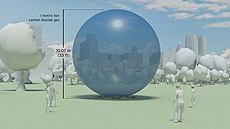Keeping track of our changing environment
 |
| This illustration shows the volume taken up by one metric ton of carbon dioxide. In 2013, the United States emitted the equivalent of 6.7 billion metric tons. By tracking how much greenhouse gas we emit and its various sources, we can work on reducing that number over time. Image: Carbon Visuals |
In climate science, collecting the right data is critical to understanding what the future holds in a world with a changing climate. Of fundamental importance is tracking greenhouse gas emissions over time.
In April, the U.S. Environmental Protection Agency released the latest report documenting emissions with its Inventory of U.S. Greenhouse Gas Emissions and Sinks. This annual report dating back to 1990 tracks U.S. total annual emissions and removal of greenhouse gases across a variety of metrics. The inventory covers seven key greenhouse gases: carbon dioxide, methane, nitrous oxide, hydrofluorocarbons, perfluorocarbons, sulfur hexafluoride and nitrogen trifluoride.
Total overall emissions were 6.7 billion metric tons of carbon dioxide-equivalent in 2013. Emissions in 2013 were 9 percent below 2005 levels. The inventory shows a 2 percent increase in overall emissions in 2013 from 2012. The increase has been attributed to increases in energy consumption and greater use of coal over the period. The largest source of emissions by sector were power plants, accounting for 31 percent of the total. The transportation sector was the second-largest at 27 percent, followed by industry and manufacturing at 21 percent.
Fermilab began keeping a comprehensive inventory in 2008, the year we first began reporting to DOE's Sustainability Performance Office on our emission sources. Our largest source, similar to the U.S inventory, is energy consumption. Although we don't generate electricity on site, we do purchase it off the grid, and it dominates our emissions, accounting for 93 percent of greenhouse gases attributable to lab operations.
Big science requires big power, and one of the ways we minimize our impact is by purchasing Renewable Energy Certificates (RECs) for a portion of the power purchased. RECs are energy commodities that demonstrate proof that the electricity was generated from a renewable energy resource. Using RECs, in 2014 the lab reduced the impact from purchased power by 19 percent from the 2008 baseline, with the intention to increase the percentage over time to meet federal emission reduction goals.
In addition to aggressively looking at energy conservation opportunities for projects and site operations, we will strategically use RECs as offsets in years ahead to further reduce lab emissions.
—Eric Mieland
|